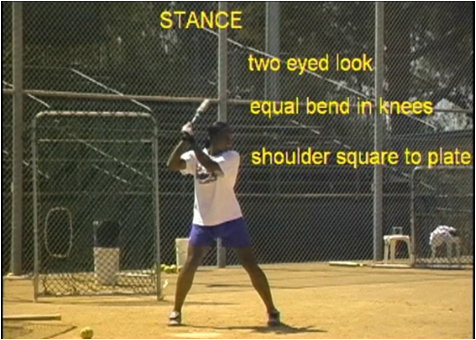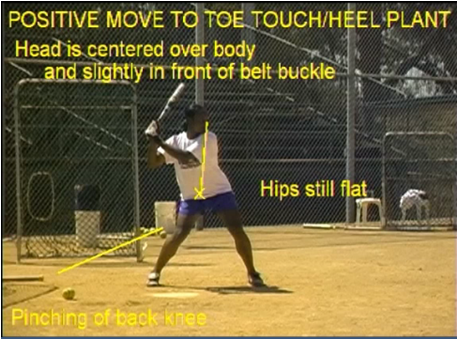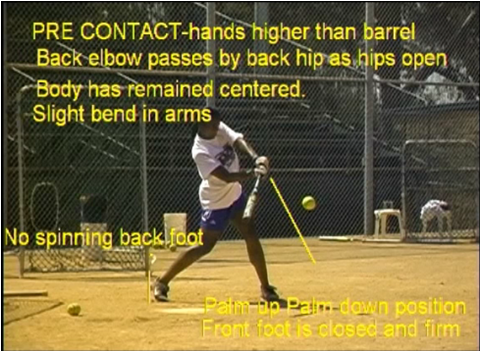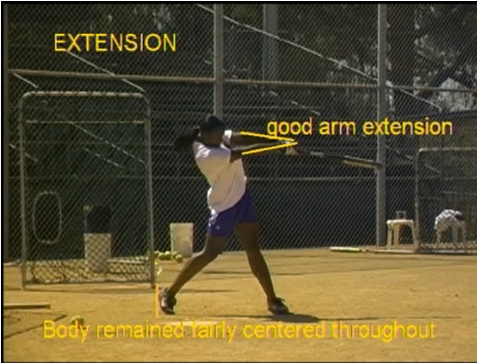- Like
- Digg
- Del
- Tumblr
- VKontakte
- Buffer
- Love This
- Odnoklassniki
- Meneame
- Blogger
- Amazon
- Yahoo Mail
- Gmail
- AOL
- Newsvine
- HackerNews
- Evernote
- MySpace
- Mail.ru
- Viadeo
- Line
- Comments
- Yummly
- SMS
- Viber
- Telegram
- Subscribe
- Skype
- Facebook Messenger
- Kakao
- LiveJournal
- Yammer
- Edgar
- Fintel
- Mix
- Instapaper
- Copy Link
In this article, we are going to illustrate 10 keys to an effective softball swing. Practicing these mechanics will help any hitter develop more bat speed, more power, and more consistency at the plate.
You’ll notice that these keys include both a “linear” move – which loads up the body prior to the swing, and a “rotational” move – which brings the bat into the hitting zone to make contact.
While there are many approaches to teaching hitting, we’ve found this to be the most effective in fastpitch softball. Full credit to 11-time NCAA Coach of the Year Sue Enquist for pioneering this method!
Recommended: Softball Hitting Skills and Drills eBook
 The Softball Hitting Skills and Drills eBook is packed with 28 innovative hitting drills that show you exactly how to develop a picture-perfect swing.
The Softball Hitting Skills and Drills eBook is packed with 28 innovative hitting drills that show you exactly how to develop a picture-perfect swing.
All explained with step by step instructions, illustrations, diagrams, and coaching tips.
Everything is easy to learn and simple to teach. So you can start using these drills TONIGHT (even if you're new to coaching).
Click here to get instant access over your computer or mobile device.
Key #1 - Stance

- Batter should have a “two eyed look” – with the head turned forward and both eyes focused on the pitcher’s release point.
- Some hitters make the mistake of turning their heads to the side and only watching the ball with the front eye. This limits depth perception and tracking of the ball.
- Feet are a little wider than shoulder width apart with an equal bend in the knees. Hitter should be in a relaxed, athletic position.
- Shoulders are square to the plate
Key #2 - Negative Move

- Batter “loads” the swing with a linear move back, away from the pitcher
- Shoulders stay level and square to the plate
- No rotation at this point
Key #3 - Positive Move

- Batter starts forward momentum
- Smooth, rhythmic movement from negative move into positive move
- Remain balanced
- Hips stay flat and square to the plate
Key #4 - Toe Touch
- Short (3-5 inch) light stride with front foot
- Head stays centered over body and slightly in front of belt buckle
- Weight is equally distributed between front and back legs
- Do not lean forward, firm up or collapse the front leg
Key #5 - Heel Plant
- Plant the front heel
- Prepare for rotation of the hips
- Maintain balance
Key #6 - Connection

- The back elbow swings down and “connects” with the back hip
- Focus on closing the gap between the back elbow and back hip
- Head remains centered over belly button
- Weight starts to transfer to front side
- Back elbow leads the hands
- No dropping or dipping the barrel of the bat
- Front toe is closed to the pitcher
Key #7 - Bat Lag

- The barrel comes down to an even plane with the hands
- Hips are starting to turn in a rotational movement
- Front leg starts firming up

- At Pre-Contact, hands are higher than the barrel of the bat
- Back elbow passes back hips as the back hips open up
- Body remains centered – no lean forward or backward
- Slight bend in arms
- Back heel comes up but does NOT spin or “squish the bug”
- Hands are in palm up palm down position
- Front foot remains closed and firm
Key #8 - Contact

- Wrist-snap: release the back wrist (top hand) as ball meets the bat
- Top hand can stay on bat or let go
- Front arm has a slight bend
- Hands are always higher than the ball
Key #9 - Extension

- Shoulders and arms extend out and form a triangle (“Power V”)
- Body remains balanced and centered
- Do not spin off the ball (caused by premature turning of the back foot)
Key #10 - Follow Through

- High finish
- Weight has transferred forward to the front foot
- Release of the firm front leg
- Up on the ball of the back foot
- Body remains fairly centered throughout
Coach Enquist has a variety of unique drills you can use to reinforce these mechanics, and help improve your hitters’ bat speed and power. You can find 28 of them inside the Softball Hitting Skills and Drills eBook. Download your copy today!
- Like
- Digg
- Del
- Tumblr
- VKontakte
- Buffer
- Love This
- Odnoklassniki
- Meneame
- Blogger
- Amazon
- Yahoo Mail
- Gmail
- AOL
- Newsvine
- HackerNews
- Evernote
- MySpace
- Mail.ru
- Viadeo
- Line
- Comments
- Yummly
- SMS
- Viber
- Telegram
- Subscribe
- Skype
- Facebook Messenger
- Kakao
- LiveJournal
- Yammer
- Edgar
- Fintel
- Mix
- Instapaper
- Copy Link